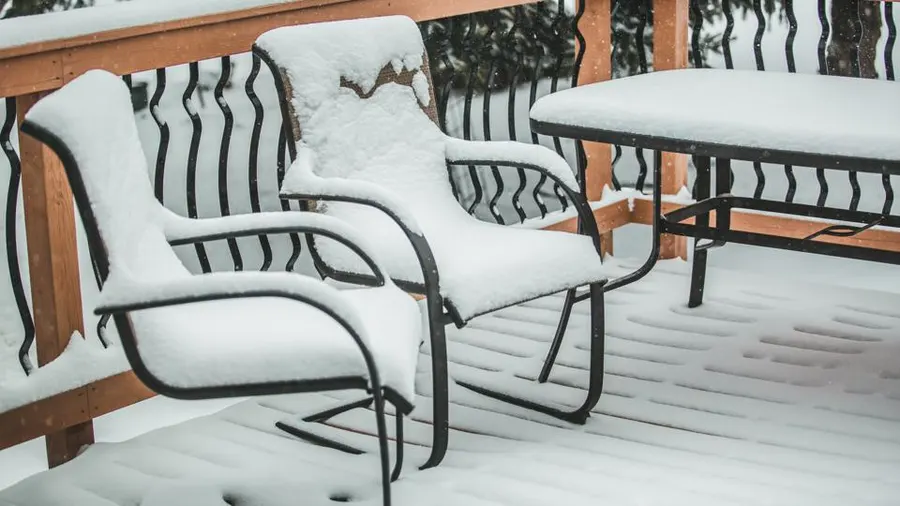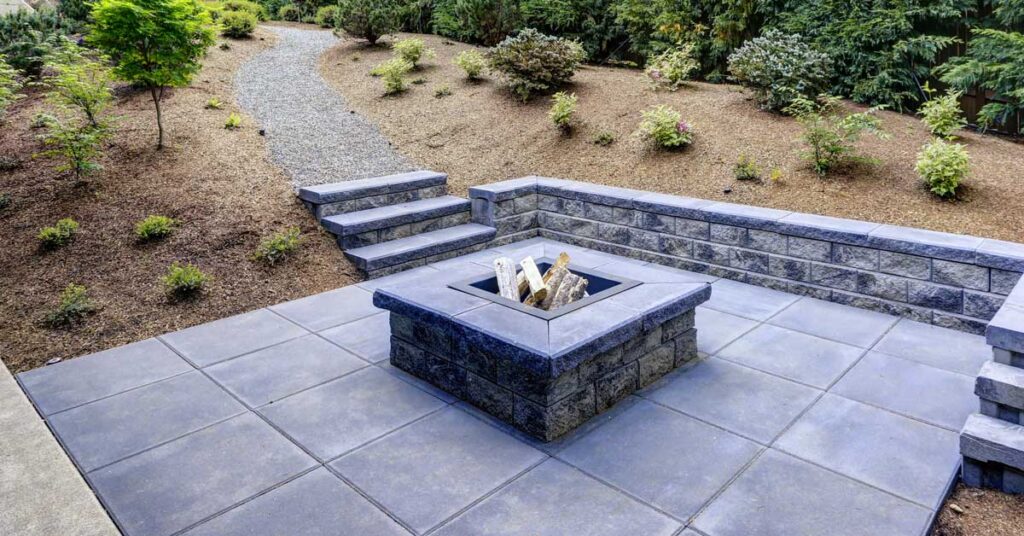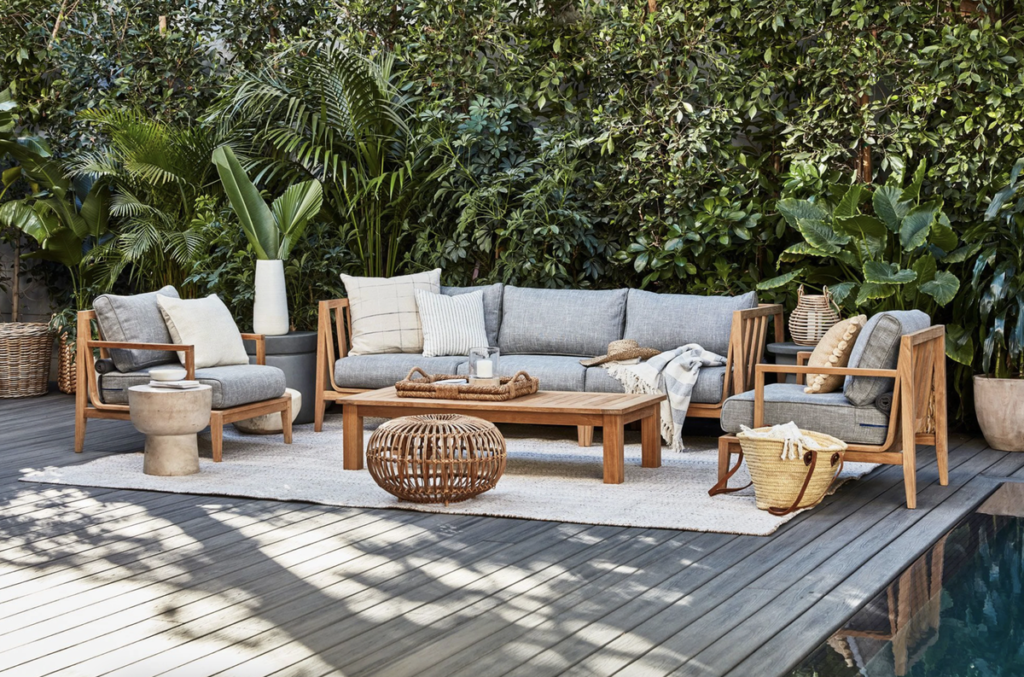What is Metal Patio Furniture?
Metal patio furniture is a popular choice for homeowners looking to furnish their outdoor spaces. It offers durability, strength, and a sleek modern look. Metal furniture is available in various materials such as aluminum, wrought iron, and steel. Each material has its unique properties and features, making it essential to know about the type of metal furniture that will suit your needs best.
Wrought iron furniture is known for its classic and elegant look that adds value to any outdoor area. It is made from iron that is heated and molded into different shapes. Wrought iron furniture is heavy and durable, perfect for windy or exposed areas. This type of metal furniture requires minimal maintenance, and a simple wash with soap and water can keep it looking good for many years.
Aluminum furniture is lightweight and requires little to no maintenance, making it a popular choice for outdoor patios. It comes in various styles and is available in different colors, making it easy to match your outdoor décor. Aluminum is resistant to rust, and it withstands different weather conditions, making it ideal for the winter months.
Steel furniture is sturdy and heavier than aluminum furniture, making it perfect for areas with heavy winds. The material is coated with a rust-resistant finish, making it durable during harsh weather conditions. Steel furniture comes in different styles and is available in different colors, making it easy to find the perfect piece for your outdoor area.
In conclusion, metal patio furniture is available in various materials, each with unique features and properties. Understanding the type of metal furniture that suits your needs best can help you choose a reliable and functional piece of furniture that can last many years. Whether you prefer a classic and elegant look or a modern sleek look, there is a metal furniture option out there that can match your requirements.
Why Leave Metal Patio Furniture Out in Winter?
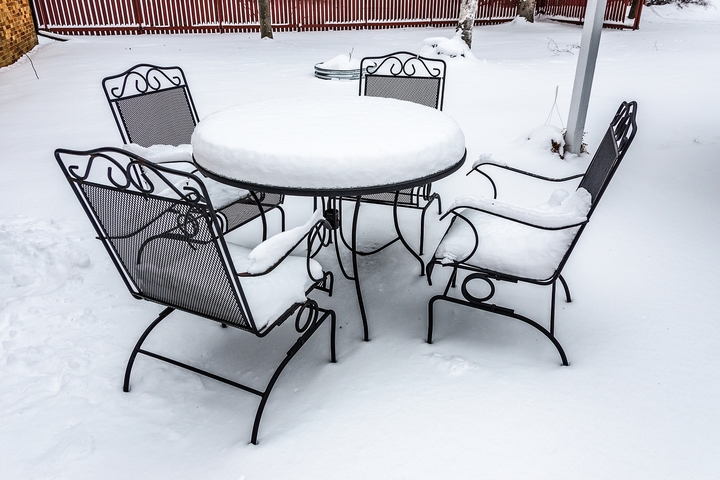
When the weather turns cold and the days become shorter, it’s time to prepare your outdoor space for winter. One question that often arises is whether or not you should leave your metal patio furniture outside during the winter months. The answer is yes, as long as you take a few precautions.
One of the main advantages of metal patio furniture is its durability. Whether it’s wrought iron, aluminum, or steel, metal is a strong material that can withstand the elements. For this reason, it’s often a popular choice for outdoor furniture that can last for many years. Leaving it outside in the winter can actually be beneficial, as it can protect your furniture from moisture buildup and rust.
That being said, it’s important to take some precautions to ensure your furniture stays in good condition. First and foremost, it’s a good idea to clean your metal furniture before storing it away for the winter. Simply wash it down with soap and water, making sure to dry it thoroughly afterward. This will help prevent any potential rust buildup.
If you don’t have the storage space to bring your furniture inside, consider investing in covers specifically designed for outdoor furniture. These covers will provide extra protection from the elements, keeping your furniture clean and dry. Look for covers that are made from durable materials and that can be secured with bungee cords to prevent them from blowing away.
When it’s time to bring your furniture back out in the spring, make sure to inspect it thoroughly for any signs of damage. Pay close attention to any joints or connections that could have been weakened by the cold weather. If you notice any issues, be sure to address them before using your furniture again.
In summary, leaving your metal patio furniture outside in the winter is perfectly fine, as long as you take the necessary precautions. Clean your furniture and invest in covers, if necessary, to keep it in good condition. With a little extra care, your metal furniture will continue to be a beautiful and functional addition to your outdoor space for many years to come.
Types of Metal Patio Furniture
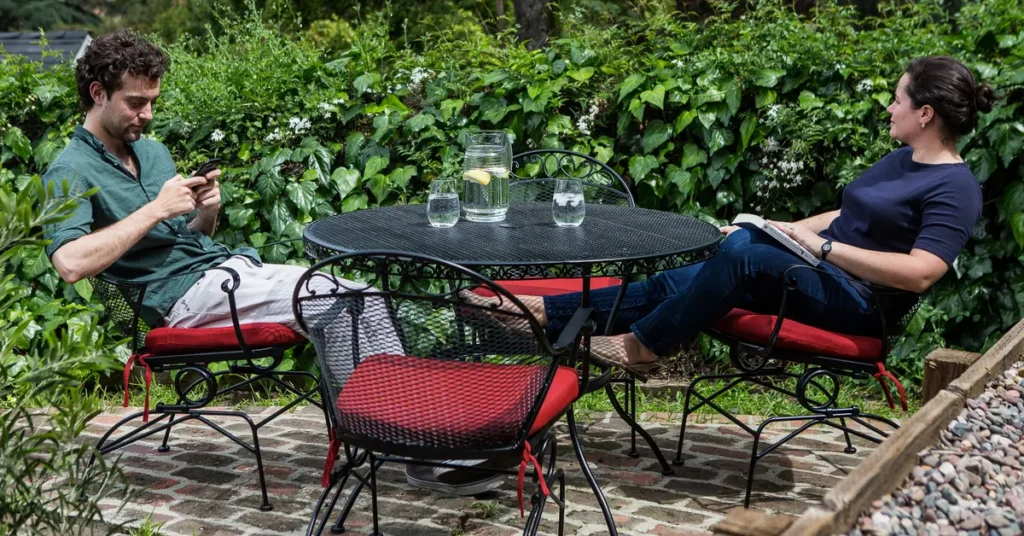
Metal patio furniture is a popular choice for people who want sturdy and durable furniture for their outdoor spaces. This type of furniture can withstand the harsh weather conditions that come with being outside, making it ideal for homeowners who want furniture that will last for many years. There are several types of metal patio furniture to choose from, including wrought iron, aluminum, and steel.
Wrought Iron Patio Furniture
Wrought iron patio furniture is a classic choice for those who want a traditional and elegant look. This type of furniture is heavy and sturdy, making it perfect for windy areas. It can also be customized with intricate designs and patterns, adding a touch of artistry to any outdoor space. However, it’s important to note that wrought iron furniture requires a bit of maintenance to prevent rust buildup.
Aluminum Patio Furniture
Aluminum patio furniture is a popular choice for those who want lightweight furniture that’s easy to move around. This type of furniture is resistant to rust and corrosion, making it perfect for areas that experience wet conditions. It’s also available in a variety of styles and colors, making it easy to match your home’s décor.
Steel Patio Furniture
Steel patio furniture is a strong and durable option for those who want something that can withstand heavy use. It’s also available in a variety of styles and colors, making it easy to match your outdoor space. However, steel furniture requires a bit of maintenance to prevent rust buildup, so it’s important to keep it clean and dry.
When choosing metal patio furniture, it’s important to consider your needs and preferences. Each type of metal has its own unique characteristics and care requirements, so it’s essential to research and choose the best option for you. Whether you prefer classic wrought iron or lightweight aluminum, metal patio furniture is sure to provide durability and style to your outdoor space.
Cast Iron Furniture
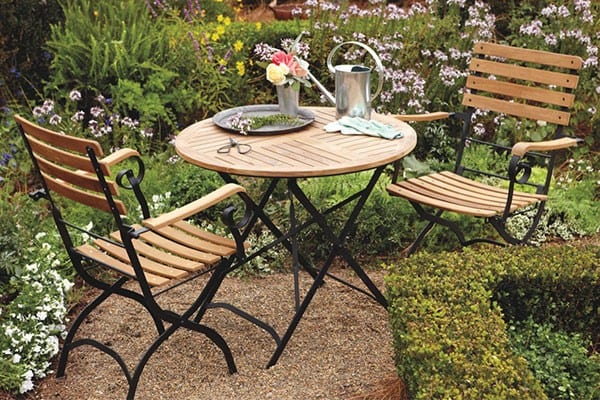
Cast iron furniture is a popular choice for adding a touch of vintage charm to any outdoor space. This type of furniture is made by pouring molten iron into molds, resulting in sturdy and durable pieces that can withstand harsh weather conditions. Cast iron furniture is available in a variety of designs and styles, from ornate Victorian patterns to sleek modern designs.
One of the benefits of cast iron furniture is its weight and stability. It’s heavier than other types of outdoor furniture, making it less likely to tip over or blow away in strong winds. This makes it a great choice for windy areas or outdoor spaces that are prone to gusts of wind.
While cast iron furniture is durable, it’s still important to take proper care of it if you want it to last. One of the downsides of cast iron furniture is that it can rust over time, especially if it’s exposed to moisture. To prevent rust buildup, it’s important to clean your cast iron furniture regularly and keep it dry. If you notice any signs of rust, you can use a wire brush to remove it and then apply a rust inhibitor to prevent further damage.
Cast iron furniture is also prone to chipping and cracking, especially if it’s dropped or hit with a heavy object. If you do notice any cracks or chips in your furniture, it’s best to address them right away to prevent further damage. You can use epoxy or cast iron welding to repair any cracks or chips in your furniture.
Overall, cast iron furniture is a great choice for those who want a sturdy and stylish option for their outdoor space. Just be sure to take proper care of it to ensure it lasts for years to come. With a bit of extra care and maintenance, your cast iron furniture will continue to be a focal point of your outdoor living area for many years to come.
Aluminum Furniture

Aluminum furniture has become increasingly popular in recent years due to its durability and stylish design. It’s a great choice for outdoor furniture since it’s lightweight and easy to move around, but it’s also strong enough to withstand harsh weather conditions.
One of the biggest advantages of aluminum furniture is its rust-resistant properties. Unlike other metals, aluminum won’t rust or corrode over time, even in wet conditions. This makes it a great choice for outdoor spaces that are exposed to rain or humidity.
Aluminum furniture is also very easy to take care of. To keep it looking its best, simply wipe it down with a damp cloth and mild soap. Avoid using abrasive cleaners or scrubbers as they can scratch the surface of the furniture.
While aluminum furniture is durable, it’s not invincible. It’s important to take extra precautions during the winter months, especially if you live in an area with harsh weather conditions. To protect your furniture during the winter, cover it with a furniture cover or store it in a dry and sheltered area.
Aluminum furniture is available in a range of styles and designs, from simple and minimalistic to elaborate and ornate. It’s a great option for those who love to incorporate their personal style into their outdoor spaces. Whether you’re looking for a sleek and modern dining set or a cozy and comfortable lounge chair, there’s an aluminum furniture piece to fit every style.
In conclusion, aluminum furniture is a great choice for outdoor spaces due to its durability, low maintenance, and stylish design options. With proper care and maintenance, your aluminum furniture can last for years to come.
Wrought Iron Furniture
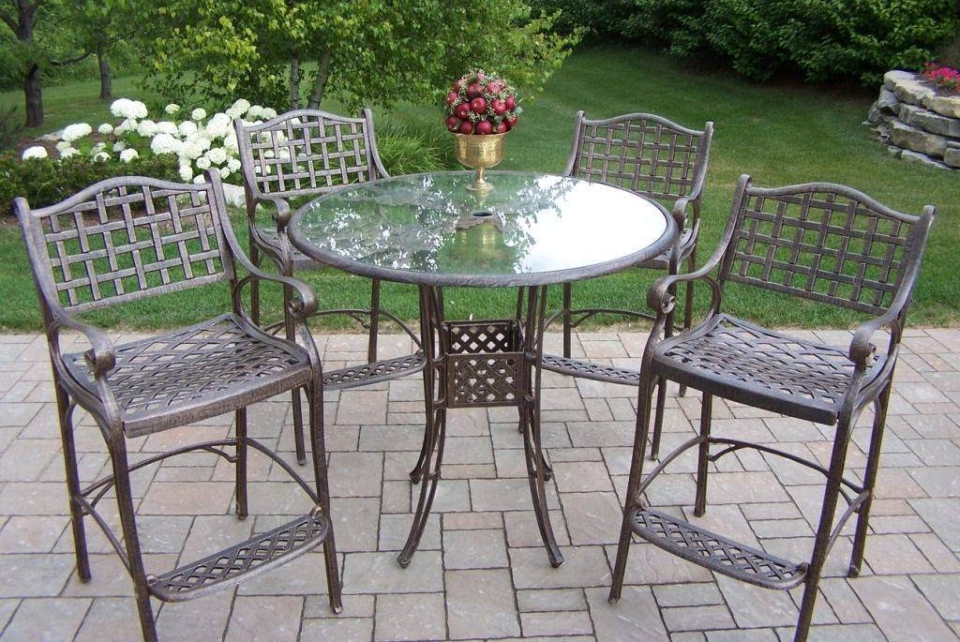
Wrought iron furniture has been a popular choice for outdoor spaces for decades, and for good reason. This type of furniture is known for its durability, strength, and classic beauty. If you’re considering purchasing wrought iron furniture for your patio or garden, there are a few things you should know about this popular material.
First of all, it’s important to understand what wrought iron is. Unlike modern steel, which is made by heating and melting iron ore, wrought iron is created through a much more labor-intensive process. Wrought iron is made by heating and hammering raw iron ore, which is then shaped into various forms. This process creates a unique and distinctive look that sets wrought iron furniture apart from other types of outdoor furniture.
One of the biggest advantages of wrought iron furniture is its durability. Wrought iron is incredibly strong, which means that it can stand up to even the toughest weather conditions. If your furniture will be exposed to rain, sleet, or snow, wrought iron is a great choice. Plus, wrought iron furniture is heavy and sturdy, which makes it less likely to blow away or tip over during windy conditions.
While wrought iron furniture is durable and strong, it’s important to take proper care of it to ensure that it lasts for years to come. To keep your wrought iron furniture looking its best, be sure to clean it regularly with warm water and a mild soap. You can also use a soft-bristled brush to remove any dirt or debris that may have accumulated on the surface.
Another important consideration when purchasing wrought iron furniture is the design and style. Wrought iron furniture can be designed in a variety of styles, from traditional and ornate to sleek and modern. You can choose from a range of different finishes, including black, white, or even brightly colored finishes. No matter what your personal style preferences may be, there’s a wrought iron furniture design that will work for you.
Finally, it’s worth noting that wrought iron furniture can be heavy and difficult to move. If you plan to rearrange your outdoor spaces frequently, wrought iron furniture may not be the best choice for you. However, if you’re looking for a durable and beautiful outdoor furniture option that will stand the test of time, wrought iron furniture is definitely worth considering.
Steel Furniture

Steel furniture is a popular choice for many homeowners who want durable, industrial-looking pieces that can withstand wear and tear. Made from one of the world’s strongest materials, steel furniture can be used both indoors and outdoors and is perfect for those looking for furniture that can last a lifetime.
One of the biggest advantages of steel furniture is its resilience. Steel is resistant to rust, corrosion, and decay, making it an excellent choice for outdoor furniture that is exposed to the elements. It is also incredibly strong and durable, able to withstand heavy use without showing signs of wear and tear.
Steel furniture is also highly customizable, with many manufacturers offering a range of finishes, colors, and designs to choose from. These pieces are available in everything from sleek, modern styles to more traditional, ornate designs, making it easy for homeowners to find a look that fits their personal aesthetic.
When it comes to upkeep, steel furniture is relatively low maintenance. It can be easily cleaned with soap and water or a mild cleaning solution, and little extra care is needed to keep it looking great. However, it is important to remember that steel can scratch or dent if hit with a hard object, so it’s best to avoid harsh chemicals and abrasive cleaning tools.
Additionally, while steel furniture is strong and durable, it is heavier than other types of outdoor furniture, making it more difficult to move when needed. To prevent damage to floors and other surfaces, it is often wise to invest in furniture pads or gliders to help move the pieces around as needed.
In conclusion, steel furniture is an excellent choice for anyone seeking durable, long-lasting furniture that can stand up to heavy use and outdoor exposure. With a wide range of styles and finishes available, there is a steel furniture design that will meet the needs and aesthetic preferences of almost any homeowner.
Assessing Your Specific Situation
When it comes to determining whether or not you can leave your metal patio furniture outside during the winter months, it is important to assess your specific situation. There are a variety of factors that can impact the safety and durability of your outdoor furniture, from the type of material it is made from to the weather conditions in your area.
One of the first things to consider is the type of metal your furniture is made from. Aluminum and steel are both popular choices for outdoor furniture, but they can have different reactions to cold weather. While aluminum is generally resistant to corrosion and rust, it can become brittle in extreme cold conditions. Steel, on the other hand, is more durable and can withstand colder temperatures, but is more susceptible to rust and corrosion if not properly treated.
Next, think about the specific weather conditions in your area. Does it snow frequently? Are there high winds or heavy rainstorms? Cold and wet conditions can cause damage to your outdoor furniture, so it is important to take these factors into consideration. Additionally, if you live in an area with harsh winter weather, you may want to invest in furniture covers or store your pieces indoors to keep them protected.
Another important factor to consider is the amount of storage space you have available. If you have the room to store your furniture indoors during the winter months, this may be the safest choice. However, if you do not have enough space to store all of your pieces, you may need to take extra precautions to protect them. This could include using furniture covers, securing the furniture with bungee cords, or placing it in a sheltered area of your outdoor space.
Ultimately, the decision of whether or not to leave your metal patio furniture outside during the winter months is a personal one. Assessing your specific situation and considering the unique factors that could impact your pieces will help you make an informed decision. With the right care and attention, your outdoor furniture can last for years to come, even in the harshest of winter weather conditions.
Weather Conditions and Temperature Considerations
When it comes to leaving outdoor furniture outside in the winter, weather conditions and temperature considerations are crucial factors to take into account. If you live in an area with harsh winter weather, it is essential to ensure that your patio furniture is able to withstand the cold temperatures and any precipitation that may occur.
First and foremost, it is crucial to determine the type of furniture you have and its level of durability. Different materials have varying levels of resistance to cold and wet weather conditions. Wood furniture, for example, may be more susceptible to warping or cracking in extreme cold and wet weather. On the other hand, synthetic wicker or metal furniture with weather-resistant coatings can better withstand these conditions.
Additionally, fluctuations in temperature can also affect outdoor furniture. Between daytime and nighttime temperatures, significant differences may occur that cause materials to expand and contract. This can lead to damage or wear over time, which is especially important to consider when choosing furniture made of wood or natural rattan.
It is also important to note that while metal patio furniture is generally durable, it can become brittle in extreme cold weather conditions, such as those experienced in northern climates. Extra protection such as using furniture covers is recommended, or storing the furniture inside during the winter months.
Another type of furniture that may require extra care during cold months is teak furniture. While teak is naturally weather-resistant, it requires regular maintenance to keep it looking its best. Treating the furniture with warm water and mild soap can help to prevent any water leaks or damage that may occur in colder weather.
In summary, when leaving outdoor furniture outside in the winter months, it is important to take into account both weather conditions and temperature considerations. By choosing durable materials, taking proper precautions, and regularly maintaining your furniture, you can keep it looking its best and enjoying it for years to come.
Local Precipitation Patterns

Local precipitation patterns can vary greatly depending on a variety of factors such as geography, weather fronts, and prevailing winds. Understanding these patterns can be helpful for many reasons, from planning outdoor activities to managing water resources.
One of the primary factors that impacts local precipitation patterns is geography. Areas near mountains or bodies of water often experience higher levels of precipitation due to the geographic features. For example, coastal regions are more likely to experience rain as moist ocean air is pushed onto the shore by prevailing winds. On the other hand, areas that are further inland may experience more arid conditions due to a lack of moisture in the air.
Another major factor that influences local precipitation patterns is weather fronts. When cold and warm air masses meet, weather fronts can form, leading to the development of precipitation. In addition to affecting precipitation patterns, weather fronts can also impact temperature and cloud cover.
Prevailing winds can also impact local precipitation patterns. In some areas, winds can bring in moisture from distant regions, leading to increased precipitation. In other areas, winds may be drier, leading to a more arid climate.
Understanding local precipitation patterns is especially important for water resource management. In areas with limited water supplies, knowing the precipitation patterns can help with planning and conservation, as well as predicting potential drought conditions.
Overall, local precipitation patterns can vary greatly depending on a range of factors. By understanding these patterns, individuals and communities can better plan for outdoor activities, manage water resources, and prepare for potential weather events.
Humidity Levels
Humidity levels can have a significant impact on both our comfort and health. High humidity can make us feel sweaty, sticky, and uncomfortable, while low humidity can lead to dry skin, chapped lips, and respiratory issues. Therefore, it’s essential to understand how to manage humidity levels both inside and outside of our homes.
To start, it’s useful to know what humidity is and how it’s measured. Humidity refers to the amount of water vapor present in the air. It’s measured using a device called a hygrometer, which calculates the relative humidity as a percentage.
The ideal indoor humidity levels range from 30% to 50%. This range provides a comfortable level of moisture in the air, which can help prevent the negative effects of both high and low humidity. To maintain these levels, it’s essential to ensure proper ventilation, particularly in areas with high moisture, such as basements and bathrooms. Additionally, using a dehumidifier or humidifier can be beneficial in regulating indoor humidity levels.
When it comes to outdoor humidity levels, the ideal range differs based on the climate. Areas with high humidity, such as in tropical climates, may have outdoor humidity levels ranging from 60% to 90% or more. However, in arid climates, humidity levels may be as low as 10%. Understanding outdoor humidity levels can be helpful in planning outdoor activities and staying cool and hydrated during hot and humid weather.
It’s also crucial to manage humidity levels in the workplace, particularly in industries where high humidity levels can impact production and worker safety. HVAC systems and industrial ventilation can help regulate humidity levels in these settings.
In conclusion, understanding and managing humidity levels is crucial for our comfort and health, both indoors and outdoors. By using tools such as hygrometers, dehumidifiers, and humidifiers, we can ensure that humidity levels remain within the ideal range for our well-being.
Preparing Your Metal Patio Furniture for Winter Storage
With winter upon us, it’s time to start thinking about preparing your outdoor furniture for storage. When it comes to metal patio furniture, taking the necessary steps to protect it from the harsh winter weather can help extend its lifespan and maintain its appearance. Here are some tips for preparing your metal patio furniture for winter storage:
Clean and Dry the Furniture
Before storing your metal patio furniture, it’s important to give it a thorough cleaning. Use a mild soap and warm water to wipe down the surface of the furniture, taking care to remove any dirt, dust, or debris. Once the furniture is clean, allow it to dry completely before storing it. This can help prevent rust or other damage from developing over the winter months.
Apply a Protective Coating
To further protect your metal patio furniture, consider applying a protective coating before storing it away. There are a variety of options available, including spray-on coatings or wax-based products designed specifically for outdoor furniture. These coatings can help provide an extra layer of protection against the elements and keep your metal furniture looking its best for years to come.
Cover the Furniture
Once your metal patio furniture is clean and dry, it’s time to prepare it for storage. One way to protect your furniture is by covering it with a weather-resistant cover. This can help prevent moisture and debris from accumulating on the furniture during the winter months. Be sure to choose a cover that’s specifically designed for outdoor furniture and fits your particular pieces properly.
Store the Furniture in a Dry Location
Finally, it’s important to store your metal patio furniture in a dry location during the winter months. Moisture can be particularly damaging to metal furniture, so avoid storing it in areas with high humidity or where it’s likely to get wet. If possible, store your furniture inside a dry garage or shed to provide extra protection against the elements.
By taking these steps to prepare your metal patio furniture for winter storage, you can help extend its lifespan and maintain its appearance for years to come. Remember to clean and dry the furniture, apply a protective coating, cover it with a weather-resistant cover, and store it in a dry location to keep it in top condition throughout the winter season.
Cleaning the Surface of the Furniture
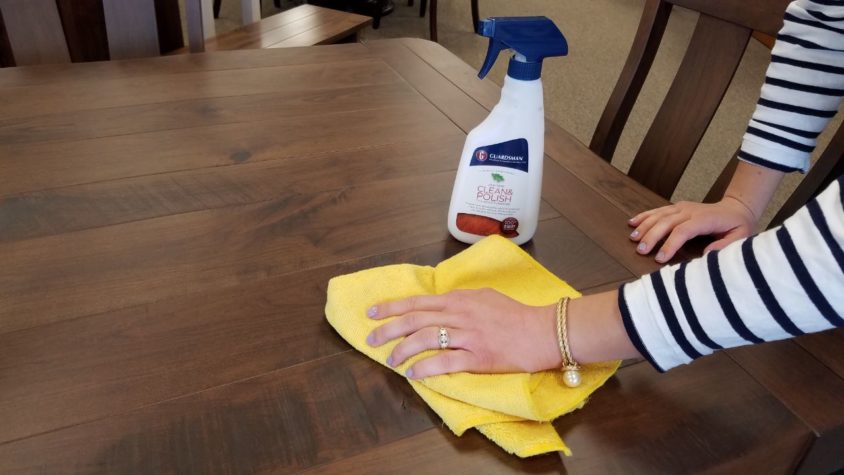
When it comes to preparing your metal patio furniture for the winter months, one crucial step is to give the surface of your furniture a thorough cleaning. Over time, outdoor furniture can accumulate dirt, dust, and debris, which can lead to discoloration or damage if left unaddressed.
To clean the surface of your metal patio furniture, start by preparing a solution of mild soap and warm water. Apply the solution to a soft-bristled brush or cloth and gently scrub the surface of the furniture, taking care to reach every nook and cranny.
Be sure to pay special attention to any areas that may have accumulated dirt or grime, such as the slats on a metal bench or the crevices of a decorative metal table. If necessary, use a toothbrush or small scrub brush to get into tight corners or hard-to-reach areas.
Once you’ve thoroughly cleaned the surface of your furniture, rinse it off with a hose or bucket of clean water. Use a sponge or cloth to absorb excess water and dry the furniture completely before proceeding to the next step.
Keep in mind that different types of metal furniture may require different cleaning methods, so be sure to consult your manufacturer’s instructions before you begin. Additionally, if you’re unsure about how to clean a particular item, it’s always a good idea to consult a professional or ask for advice from your local hardware or home improvement store.
By taking the time to clean the surface of your metal patio furniture before storing it for the winter, you can help ensure that it stays in good condition and looks its best for years to come. So roll up your sleeves, grab your cleaning supplies, and get ready to give your outdoor furniture the TLC it deserves!
Fading Prevention Techniques
Fading is a common problem that plagues many different types of materials, from fabric to furniture to even car paint. It’s caused by exposure to sunlight and can be exacerbated by other factors such as humidity and temperature. The good news is that there are ways to prevent fading and protect your valuable items from this type of damage.
One of the most effective ways to prevent fading is to use UV-resistant materials. Many fabrics and materials that are specifically designed for outdoor use are treated with special coatings that help to block UV rays. This can include everything from patio furniture cushions to awnings to car covers.
Another strategy is to minimize exposure to sunlight altogether. This can be accomplished by placing furniture or other items in shaded areas or by using umbrellas or awnings to provide extra shade. For vehicles, parking in a covered garage or carport can help to minimize exposure to direct sunlight.
Additionally, it’s important to keep items clean and well-maintained. Dust, dirt, and grime can all contribute to fading as they can absorb and reflect sunlight. Regular cleaning, using non-abrasive cleaners and gentle brushes or cloths, can help to remove these contaminants and prevent them from damaging the material.
Another technique for preventing fading is to use protective coatings or sprays. These can be applied to fabrics, furniture, and even paint to help protect against UV rays and other environmental factors. Some of these coatings also contain additives that can help to prevent mold and mildew growth, which can also contribute to fading.
Overall, the key to preventing fading is to be proactive and take steps to protect your items before they start to show signs of damage. By using UV-resistant materials, minimizing exposure to sunlight, keeping items clean and well-maintained, and using protective coatings or sprays, you can help to ensure that your valuable items stay looking their best for years to come.
Rust Prevention Techniques
Rust is a common problem for many metals, especially those that are exposed to the elements. Rust can cause damage to the metal and shorten its lifespan. Fortunately, there are several rust prevention techniques that can be used to protect metal items and keep them looking great for years to come.
One of the most effective ways to prevent rust is by applying a protective coating. There are a variety of different coatings available, such as paint, oil, and wax. These coatings create a barrier between the metal and the environment, preventing moisture and air from coming into contact with the metal surface.
Another rust prevention technique is to use galvanization. This is a process in which a protective layer of zinc is coated onto the metal surface. The zinc coating acts as a sacrificial layer, which means that if the coating is scratched or worn away, the exposed metal will still be protected by the remaining zinc.
Regular cleaning and maintenance are also important for rust prevention. Keeping the metal clean and dry can help to prevent rust from forming. Any dirt or debris on the surface of the metal can trap moisture, which can lead to rust formation. Using a mild soap and warm water to clean the metal can help to remove any contaminants and prevent rust from forming.
Another rust prevention technique is to use a rust inhibitor. These are chemicals that can be applied to the metal surface to prevent rust from forming. They work by reacting with the metal surface to create a protective barrier that inhibits the formation of rust.
Finally, keeping metal items in a dry environment can also help to prevent rust formation. Moisture is the enemy of metal, so storing metal items in a dry environment can help to prevent rust from forming. If storing metal items outside, be sure to cover them with a weather-resistant cover to prevent moisture from accumulating.
In conclusion, there are many rust prevention techniques that can be used to protect metal items. Applying a protective coating, using galvanization, regular cleaning and maintenance, using rust inhibitors, and storing items in a dry environment are all effective methods to prevent rust formation and prolong the lifespan of metal items. By taking these steps, you can ensure that your metal items stay rust-free and looking great for years to come.

